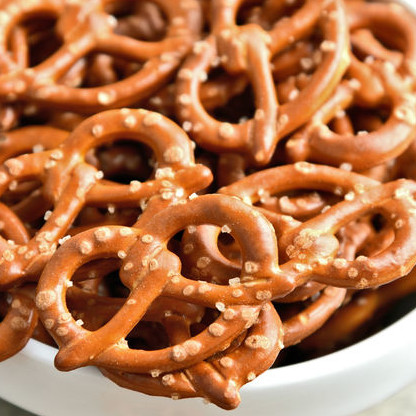
Pretzels
Also known as hard pretzels
What are Pretzels?
Pretzels are uniquely shaped baked snacks manufactured from a lean and stiff fermented wheat flour dough. They are typically treated with a sodium hydroxide or other alkali salts prior to baking and topped with coarse or Kosher salt. They are available in a variety of flavors and colors.
Two main features set pretzels apart from other baked goods:
- Alkali surface treatment
- Leavening with both yeast and chemical leaveners
Origin
Pretzels are one of the oldest and most popular baked snack foods. They were developed about 800 years ago and are especially prevalent in the European community and the United States. Among salty snacks, pretzels contain fewer calories.1
How pretzels are made
Flour, starch, protein, yeast, shortening and very small amounts of sugar make up the base formation. Interestingly, a pretzel dough requires both yeast and chemical leavening agents. In addition, pretzels require a lye bath to obtain their characteristic dark crust and distinctive flavor.1
| Ingredient | Baker’s % (based on flour weight) |
| Soft wheat flour | 100.0 |
| Water | 45.0–47.0 |
| Shortening | 2.0–3.0 |
| Non-diastatic malt (enzyme-inactive) | 2.0–3.0 |
| Instant dry yeast (IDY) | 0.25–0.50 |
| Ammonium bicarbonate | 0.15 |
| Flaked or coarse salt * | 1.5–2.0 |
* The flaked or coarse salt is sprinkled onto the pretzel dough before baking.
Processing3
- Ingredients scaling
- Mixing: Combine dry and liquid ingredients, and mix to form a coarse or stiff dough. Full gluten development and maximum extensibility are not the target in pretzel production.
- Intermediate proofing: Introduce the bulk dough in a proof box set at 28oC (83°F) and 85% relative humidity for 30 minutes.
- Rolling (dough sheeting). Gradually sheet the dough through a pair of rolls first set at 0.79 cm (5/16 in), then at 0.48 cm (3/16 in), and 0.31 cm (1/8 in). The dough sheet should be thinned to 2 mm. In case of manual rolling, use a roller pin to obtain higher precision in final sheet thickness.
- Final dough forming: With a bench scraper, cut the dough into rectangular strips (2.8 x 0.80 in) (7 x 2 cm). Hand-roll the strip into a cylinder and then make the typical tie bow configuration.
- Final proofing: Place tie bow dough in the proof box for 20–30 minutes.
- Lye washing: Immerse pretzel dough pieces for 10 to 25 seconds in a 1.25% NaOH (12.5 g/L) bath previously heated to 90°C. Remove pretzels from the solution and allow draining of excess lye.
- Topping: Place pretzels on a perforated baking sheet and then top with coarse salt. Remove unstuck salt from the baking sheet.
- Baking (small-scale or homebaking): Bake pretzels for 3 minutes at 225°C (437°F) and then lower the temperature to 170°C (338°F) for 10 minutes or until the product’s moisture content is reduced to approximately 2.5%.
- Cooling: Remove pretzels from the oven and cool for 15 minutes at room temperature.
- Packaging: Given their texture and low moisture content, pretzels must be packaged in laminated or co-extruded bags that have a good barrier against air humidity and gases.
Application
Hard or snack pretzels require a unique baking cycle. In this case baking is performed in three or two sequential steps with different time / temperature profiles:
- Pretzels are first baked and then kilned to drop the moisture content to produce the typical texture. Baking is continuously performed on wire mesh, direct gas-fired ovens that have at least three independent temperature zones or areas.
- The common oven conditions for the high-speed production of hard pretzels are 288oC (550°F), 260oC (500°F) and 250oC (482°F) for 2.5 to 3 minutes. A good pretzel should have a dark brownish outer crust and a white inner crumb with small and finely distributed gas cells.
Focus on two proofing steps
The objective of the two proofing steps is to activate the yeast so as to produce CO2 gas and other valuable yeast metabolites and flavor compounds. The carbon dioxide gas is necessary to slightly increase the pretzel volume and form the typical crumb structure. These steps along with alkaline pH are responsible for generating fermented and other flavor compounds, typical of pretzels.
References
- Serna-Saldivar, S.O. “Production of Breakfast Cereals and Snack Foods.” Cereal Grains Laboratory Reference and Procedures Manual, Delmar, CRC Press, Taylor & Francis Group, LLC, 2012, pp. 315–317.
- Morris, C.F. “Cereals: Overview of Uses: Accent on Wheat Grain.” Encyclopedia of Food Grains, 2nd edition, Volume 3 Grain-Based Products and their Processing, Academic Press, Elsevier Ltd., 2016, pp. 1–4.
- Rosentrater, K.A., and Evers, A.D. “Other food products.” Kent’s Technology of Cereals, 5th edition, Woodhead Publishing, Elsevier Ltd, 2017, pp. 707–709.

